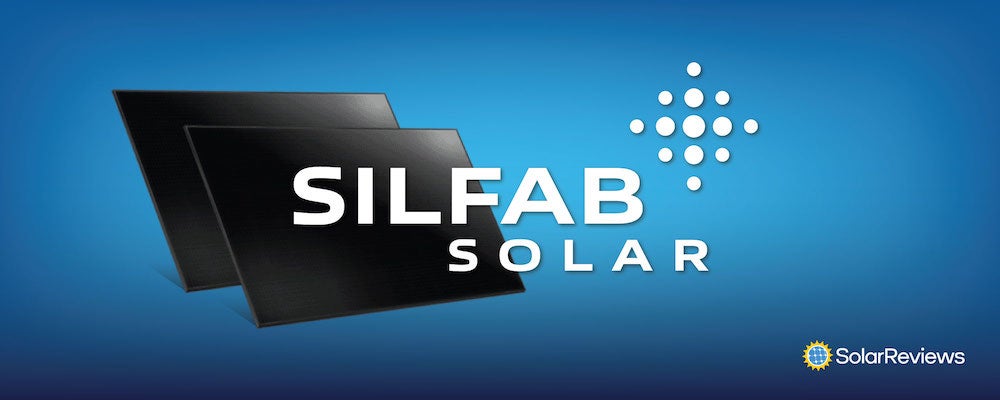
Over the past decade, Silfab Solar Inc. has established itself as one of the most prominent solar panel manufacturers in the industry. Silfab utilizes high-precision automation in its manufacturing process, which allows the company to produce high-quality products at a fast rate.
Silfab’s state-of-the-art technology isn’t the only great thing about its manufacturing facilities. Silfab Solar is a North American-based company with locations in both Canada and Washington State. That means any product you purchase from Silfab is guaranteed to be manufactured close to home and is made specifically for the American market.
In fact, many of Silfab Solar’s panels are manufactured right here in the U.S., making them Buy American Act-certified. Not to mention, Silfab’s products have been long used in the U.S. Military and Federal Aviation Administration properties - further solidifying the company’s legitimacy. The company is also looking to deepen its American roots by planning to open a solar cell manufacturing plant here sometime in the near future.
Let’s take a closer look at what Silfab Solar products are on the market and how they stack up against other solar modules.
Why you can trust SolarReviews:
SolarReviews is the leading American website for consumer reviews and ratings of residential solar panels and solar panel installation companies. Our industry experts have over two decades of solar experience combined and maintain editorial independence for their reviews. No company can pay to alter the reviews or review scores shown on our site. Learn more about SolarReviews and how we make money.Key takeaways
- Silfab Solar is a solar panel manufacturing company based in Ontario, Canada, and Bellingham, Washington, with its sights set on another location to manufacture solar cells domestically.
- Silafb currently offers two product lines: the Silfab Elite and Silfab Prime.
- Most of Silfab panels’ performance specifications generally fall within industry standards, with premium efficiency ratings.
- The average installation cost of a typically-sized Silfab Solar system will fall between $18,000 and $20,000, before incentives.
- Silfab Solar is ranked #7 among the SolarReviews top 10 solar panel manufacturers of 2023.
What products does Silfab Solar offer?
Silfab Solar manufactures solar modules for both residential and commercial installations. All of Silfab’s PV modules contain monocrystalline solar cells. The primary residential panels offered by Silfab include:
- Silfab Elite
- Silfab Prime
Silfab Elite
Image source: Silfab Solar
The Silfab Elite is the company’s highest efficiency line of solar panels and is manufactured exclusively in the United States. These high-efficiency panels come in two different wattages: 380 W and 410 W.
The panels are constructed with PERC solar cells that are manufactured in a way that produces a bit more electricity than traditional photovoltaic cells.
Additionally, the Silfab Elite panels use “back contact” solar cells, which reduces the impact of shading and allows more solar energy to be collected by each cell. The combination of PERC and back contact technology is what improves the Silfab Elite’s overall efficiency.
Silfab Prime
Image source: Silfab Solar
The Silfab Prime model is a premium-quality, half-cell solar panel. Half-cut solar cells are exactly what they sound like - solar cells that have been cut in half with a high precision laser. By making the cells smaller, the current is lowered and resistive losses are reduced. In turn, the cells are able to produce more energy.
Not only that, smaller cells are less likely to crack under stress because of their smaller surface area, making the Silfab Prime extra durable. The Silfab Prime is available in 370 watts.
How do Silfab Solar panels compare to other solar panels on the market?
| Specification | Silfab Elite | Silfab Prime |
|---|---|---|
| Power output (Pmax) | 380 W - 410 W | 370 W - 400 W |
| Efficiency rating | 21.4% | 20.2% |
| Cell type | Back contact mono-PERC | Half-cell mono-PERC |
| Power tolerance | 0 to + 10 W | 0 to + 10 W |
| Temperature coefficient (Pmax) | -0.38%/°C | -0.36%/°C |
| Workmanship warranty | 25 years | 25 years |
| Power warranty | 30 years | 30 years |
Power rating
The power rating of a solar panel (sometimes referred to as the power output or power capacity) is a measure of how much electricity it can produce.
All of Silfab’s solar panels are in line with the industry standard for power rating of monocrystalline modules. Most solar panels used by residential installers today are between 350 W and 400 W, and Silfab’s panels all fall in that range.
Cell type
In the past, solar panels were made up of either monocrystalline or polycrystalline solar cells. Almost all solar panels that are installed today are monocrystalline, which is what Silfab uses in its products.
While Silfab is following industry trends by sticking with monocrystalline silicon, they are branching out into using new technologies like half-cut and back contact cells; meaning they are making sure to keep up with newer trends.
Efficiency rating
Silfab solar panels have great efficiency ratings. Both the Elite and Prime products have efficiencies above 20%, landing them in the “premium efficiency” category among manufacturers like SunPower.
Despite that, solar panel efficiency actually isn’t as important as many manufacturers would like you to believe. Take it from SolarReviews CEO Andy Sendy, as he explains solar panel efficiency and how much it really matters in this video:
Power tolerance
Power tolerance is a measure of how much power a solar panel will produce above or below its rated power capacity under Standard Test Conditions (STC). Basically, a solar panel will have its rated power listed, but the actual amount of power it can produce can fluctuate.
All of the panels in Silfab’s product line have a power tolerance rating of -0/+10 W. This means that at any point in time, a Silfab Solar panel will be operating at least at its rated capacity, but it could operate 10 W higher.
For example, the Silfab Prime is rated at 370 W, so it will always be operating at at least 370, but it could operate at as high as 380 W under STC. The -0 tolerance rating indicates that Silfab has a high-quality manufacturing process and that the panels will hold up well under real-world conditions.
This is in line with industry standards; however, most panels usually have the power tolerance rating listed as a percentage, not as a wattage.
Temperature coefficient
A solar panel’s ability to produce power depends on its temperature. The hotter the panel, the less power the panel can produce.
To get an idea of how a solar panel is impacted by temperature changes, manufacturers include what is called a temperature coefficient. The temperature coefficient measures how much a solar PV panel’s output drops for each degree Celsius the panel’s surface gets above 25°C.
Both the Elite and Prime panels have pretty standard temperature coefficients: the Elite modules have a temperature coefficient of -0.38%/°C, while the Silfab Prime has a temperature coefficient of -0.36%/°C. This means for each degree Celsius the panel’s surface temperature is above 25°C, the output will drop by 0.36% or 0.38%.
So, if the surface of the Silfab Prime is 26°C, the power output would drop from 370 W to 368 W. It doesn’t seem like a huge difference, but as the panels get hotter in the sunlight, the production could drop much more.
Workmanship warranty
All of Silfab’s solar panels have the same workmanship product warranty. The workmanship warranty covers repairs, replacements, and refunds for defective materials.
The panels initially come with a 12-year warranty that starts on the date of delivery, but if the panels are purchased and installed by a registered Silfab installer, the warranty will be extended to 25 years.
Most panels on the market have a similar product warranty to Silfab: an initial warranty term of 10 to 15 years and the ability to register your panels for an extended 25-year warranty.
Power warranty
The power warranty, also called the performance warranty, gives homeowners an idea of how much power the solar panels will produce over time. As solar panels age, they degrade a bit and can’t generate as much power.
According to Silfab’s 30-year performance warranty, the panels will operate at 97.1% of their initial power rating after Year 1. Every year after that, the panel will not degrade more than 0.5% per year. By the end of Year 30, the panels will have a performance guarantee of 82.6% of their original rated capacity.
Going back to the Silfab Prime as an example, after one year, the power rating will drop from 370 W to 360.75 W. After 30 years, it will fall further to 305.6 W.
Almost all solar panels on the market have a yearly degradation rate of about 0.5% listed in their performance warranties. What’s great about Silfab, however, is that they offer a warranty for 30 years. Most manufacturers only warranty their panels for 25 years.
Price
Silfab solar panels cost around $0.70 per watt before installation. Other solar panels with comparable specs, like Sunpower, cost over $1.00 per watt before installation. With Silfab, you get a high-quality product for a fraction of the price.
Now, that’s not how much Silfab panels will cost when they get put on your roof. Once installation costs are considered, Silfab solar panels will cost between $2.85 per watt and $3.05 per watt.
For an average-sized solar system, you’re looking at a total cost of $18,000 and $20,000, before the solar tax credit is taken into account. That falls right in line with the average cost of solar in the U.S. of $3.00 per watt.
Aesthetic
Silfab panels don’t just perform well - they look great, too! Image source: Siflab Solar
Let’s face it - historically, solar panels have been big and bulky, which makes many homeowners hesitant to go solar.
The newer cell technologies used in Silfab’s panels don’t just boost their performance, they make the panels look better. Both the Elite and the Prime series of panels are entirely black, so they look more cohesive on your roof.
Not only that, but they can be installed at a pretty low profile so they don’t stick out as much as some of the solar panels you might think of.
Solar installers might use older Silfab modules if they still have them in stock. Don’t worry, these modules (SIL-360 NX, SIL-330 HL, and SIL-330 NL) still hold up to Silfab’s high quality standards, and hold the same extendable product warranty and 30-year performance warranty.
Are Silfab Solar panels right for your home?
If you’re looking to make the switch to solar power, Silfab Solar panels are a great choice. They offer high-quality modules and have years of experience in the industry.
Most of Silfab’s products fall right in line with industry standards, but that doesn’t mean that they’re run-of-the-mill panels. Silfab incorporates newer solar cell technology in their panels so you can ensure that you have top-of-the-line products.
But perhaps Silfab’s biggest standout feature is its roots in North America, with facilities in Ontario, Canada, and Bellingham, Washington. It’s refreshing to see since many solar panel manufacturers are based overseas, mainly in China.
Overall, Silfab Solar panels will make for a great solar power system for your home. You can find solar installers in your area that carry Silfab Solar panels by using our solar panel calculator or by checking out local customer reviews right here on our website.
